Testing of Conductive Carbon Fiber Reinforced Polymer Composites Using Current Impulses Simulating Lightning Effects
Abstract
:1. Introduction
2. Measurement System and Components Layout
3. Results
3.1. Functional Testing and Calibration
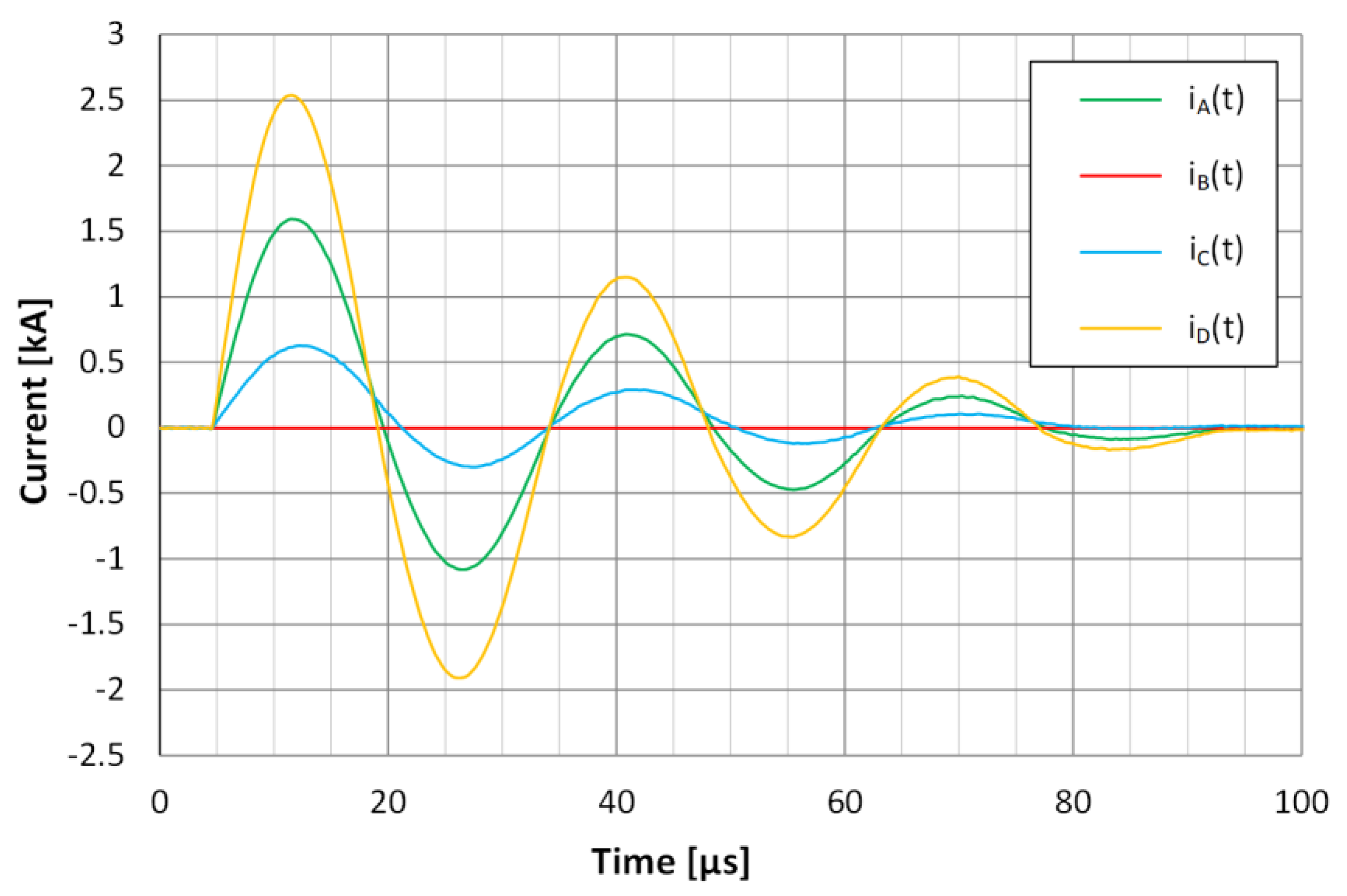
3.2. Tests of CFRP Samples
4. Conclusions
5. Patents
Author Contributions
Funding
Conflicts of Interest
References
- Shi, X.-H.; Chen, L.; Liu, B.-W.; Long, J.-W.; Xu, Y.-J.; Wang, Y.-Z. Carbon Fibers Decorated by Polyelectrolyte Complexes Toward Their Epoxy Resin Composites with High Fire Safety. Chin. J. Polym. Sci. 2018, 36, 1375–1384. [Google Scholar] [CrossRef]
- Zhang, D.; Ye, L.; Deng, S.; Zhang, J.; Tang, Y.; Chen, Y. CF/EP Composite Laminates with Carbon Black and Copper Chloride for Improved Electrical Conductivity and Interlaminar Fracture Toughness. Compos. Sci. Technol. 2012, 72, 412–420. [Google Scholar] [CrossRef]
- Hu, D.; Yi, X.; Jiang, M.; Li, G.; Cong, X.; Liu, X.; Rudd, C. Development of Highly Electrically Conductive Composites for Aeronautical Applications Utilizing Bi-Functional Composite Interleaves. Aerosp. Sci. Technol. 2020, 98, 105669. [Google Scholar] [CrossRef]
- Kastratović, G.; Grbović, A.; Sedmak, A.; Božić, Ž.; Sedmak, S. Composite Material Selection for Aircraft Structures Based on Experimental and Numerical Evaluation of Mechanical Properties. Procedia Struct. Integr. 2021, 31, 127–133. [Google Scholar] [CrossRef]
- Marx, J.C.; Robbins, S.J.; Grady, Z.A.; Palmieri, F.L.; Wohl, C.J.; Rabiei, A. Polymer Infused Composite Metal Foam as a Potential Aircraft Leading Edge Material. Appl. Surf. Sci. 2020, 505, 144114. [Google Scholar] [CrossRef]
- Setlak, L.; Kowalik, R.; Lusiak, T. Practical Use of Composite Materials Used in Military Aircraft. Materials 2021, 14, 4812. [Google Scholar] [CrossRef]
- Soutis, C. Fibre Reinforced Composites in Aircraft Construction. Prog. Aerosp. Sci. 2005, 41, 143–151. [Google Scholar] [CrossRef]
- Viscardi, M.; Arena, M.; Cerreta, P.; Iaccarino, P. Design and Prototyping of a Novel Composite Architecture for a Widebody Landing Gear Bay. Mater. Today Proc. 2021, 34, 288–292. [Google Scholar] [CrossRef]
- Xia, Q.; Zhang, Z.; Mei, H.; Liu, Y.; Leng, J. A Double-Layered Composite for Lightning Strike Protection via Conductive and Thermal Protection. Compos. Commun. 2020, 21, 100403. [Google Scholar] [CrossRef]
- Chemartin, L.; Lalande, P.; Peyrou, B.; Chazottes, A.; Elias, P.Q.; Delalondre, C.; Cheron, B.G.; Lago, F. Direct Effects of Lightning on Aircraft Structure: Analysis of the Thermal, Electrical and Mechanical Constraints. AerospaceLab 2012, 5, 15. [Google Scholar]
- Ma, X.; Wang, F.; Wang, Z.; Li, Y.; Xu, B. Thermal Dynamic Damage of Aircraft Composite Material Suffered from Lightning Channel Attachment Based on Moving Mesh Method. Compos. Sci. Technol. 2021, 214, 109003. [Google Scholar] [CrossRef]
- Zhang, J.; Zhang, X.; Cheng, X.; Hei, Y.; Xing, L.; Li, Z. Lightning Strike Damage on the Composite Laminates with Carbon Nanotube Films: Protection Effect and Damage Mechanism. Compos. Part B Eng. 2019, 168, 342–352. [Google Scholar] [CrossRef]
- Jia, S.; Wang, F.; Huang, W.; Xu, B. Research on the Blow-Off Impulse Effect of a Composite Reinforced Panel Subjected to Lightning Strike. Appl. Sci. 2019, 9, 1168. [Google Scholar] [CrossRef] [Green Version]
- Foster, P.; Abdelal, G.; Murphy, A. Understanding How Arc Attachment Behaviour Influences the Prediction of Composite Specimen Thermal Loading during an Artificial Lightning Strike Test. Compos. Struct. 2018, 192, 671–683. [Google Scholar] [CrossRef] [Green Version]
- Zhou, Y.; Chen, Y.; Liu, B.; Wang, S.; Yang, Z.; Hu, M. Mechanics of Nanoscale Wrinkling of Graphene on a Non-Developable Surface. Carbon 2015, 84, 263–271. [Google Scholar] [CrossRef]
- Chen, Y.; Ma, Y.; Wang, S.; Zhou, Y.; Liu, H. The Morphology of Graphene on a Non-Developable Concave Substrate. Appl. Phys. Lett. 2016, 108, 031905. [Google Scholar] [CrossRef]
- Shang, J.; Chen, Y.; Zhou, Y.; Liu, L.; Wang, G.; Li, X.; Kuang, J.; Liu, Q.; Dai, Z.; Miao, H.; et al. Effect of Folded and Crumpled Morphologies of Graphene Oxide Platelets on the Mechanical Performances of Polymer Nanocomposites. Polymer 2015, 68, 131–139. [Google Scholar] [CrossRef]
- Perez, R. (Ed.) Handbook of Aerospace Electromagnetic Compatibility; John Wiley & Sons, Inc.: Hoboken, NJ, USA, 2019; ISBN 978-1-118-91051-1. [Google Scholar]
- Uman, M.A.; Rakov, V.A. The Interaction of Lightning with Airborne Vehicles. Prog. Aerosp. Sci. 2003, 39, 61–81. [Google Scholar] [CrossRef]
- Chen, J.; Bi, X.; Liu, J.; Fu, Z. Damage Investigation of Carbon-Fiber-Reinforced Plastic Laminates with Fasteners Subjected to Lightning Current Components C and D. Appl. Sci. 2020, 10, 2147. [Google Scholar] [CrossRef] [Green Version]
- Filik, K.; Hajder, S.; Masłowski, G. Multi-Stroke Lightning Interaction with Wiring Harness: Experimental Tests and Modelling. Energies 2021, 14, 2106. [Google Scholar] [CrossRef]
- Maslowski, G.; Wyderka, S.; Karpinski, L.; Ziemba, R.; Karnas, G.; Filik, K.; Szczupak, P. Distribution of Long Duration Current Impulses in a Test House Lightning Protection System and Electrical Equipment. In Proceedings of the 2016 International Symposium on Electromagnetic Compatibility—EMC EUROPE, Wroclaw, Poland, 5–9 September 2016; pp. 329–334. [Google Scholar]
- Maslowski, G.; Wyderka, S. Modeling of Currents and Voltages in the Lightning Protection System of a Residential Building and an Attached Overhead Power Line. IEEE Trans. Electromagn. Compat. 2020, 62, 2164–2173. [Google Scholar] [CrossRef]
- International Electrotechnical Commission. Protection against Lightning-Part. 1: General Principles; IEC 62305-1:2010; International Electrotechnical Commission: Geneva, Switzerland, 2010. [Google Scholar]
- Hirano, Y.; Katsumata, S.; Iwahori, Y.; Todoroki, A. Artificial Lightning Testing on Graphite/Epoxy Composite Laminate. Compos. Part A Appl. Sci. Manuf. 2010, 41, 1461–1470. [Google Scholar] [CrossRef]
- Kamiyama, S.; Hirano, Y.; Okada, T.; Ogasawara, T. Lightning Strike Damage Behavior of Carbon Fiber Reinforced Epoxy, Bismaleimide, and Polyetheretherketone Composites. Compos. Sci. Technol. 2018, 161, 107–114. [Google Scholar] [CrossRef]
- Wang, B.; Duan, Y.; Xin, Z.; Yao, X.; Abliz, D.; Ziegmann, G. Fabrication of an Enriched Graphene Surface Protection of Carbon Fiber/Epoxy Composites for Lightning Strike via a Percolating-Assisted Resin Film Infusion Method. Compos. Sci. Technol. 2018, 158, 51–60. [Google Scholar] [CrossRef]
- Yin, J.J.; Chang, F.; Li, S.L.; Yao, X.L.; Sun, J.R.; Xiao, Y. Lightning Strike Ablation Damage Influence Factors Analysis of Carbon Fiber/Epoxy Composite Based on Coupled Electrical-Thermal Simulation. Appl. Compos. Mater. 2017, 24, 1089–1106. [Google Scholar] [CrossRef]
- Yinghui, Z.; Shangchen, F.; Lihua, S.; Qing, S.; Zhengyu, H. Experiment Research of CFRP Destroyed by Lightning Current. In Proceedings of the 2014 International Conference on Lightning Protection (ICLP), Shanghai, China, 11–18 October 2014; pp. 1303–1306. [Google Scholar]
- Szatkowski, G.N.; Dudley, K.L.; Smith, L.J.; Wang, C.; Ticatch, L.A. Open Circuit Resonant (SansEC) Sensor Technology for Lightning Mitigation and Damage Detection and Diagnosis for Composite Aircraft Applications. In Proceedings of the 4th AIAA Atmospheric and Space Environments Conference, New Orleans, LA, USA, 25–28 June 2012. [Google Scholar]
- Hu, T.; Yu, X. Lightning Performance of Copper-Mesh Clad Composite Panels: Test and Simulation. Coatings 2019, 9, 727. [Google Scholar] [CrossRef] [Green Version]
- Filik, K. Applications of Impulse Current and Voltage Generators Dedicated to Lightning Tests of Avionics. Electrotech. Rev. 2018, 1, 11–14. [Google Scholar] [CrossRef]
- Wang, Y. Modeling of Lightning-Induced Thermal Ablation Damage in Anisotropic Composite Materials and Its Application to Wind Turbine Blades. Ph.D. Thesis, University of Iowa, Iowa City, IA, USA, 2016. [Google Scholar]
- Szatkowski, G.N.; Dudley, K.L.; Koppen, S.V.; Ely, J.J.; Nguyen, T.X.; Ticatch, L.A.; Mielnik, J.J.; McNeil, P.A. Common Practice Lightning Strike Protection Characterization Technique to Quantify Damage Mechanisms On Composite Substrates. In Proceedings of the 2013 International Conference on Lightning and Static Electricity (ICOLSE), Seattle, WA, USA, 18 September 2013; p. 10. [Google Scholar]
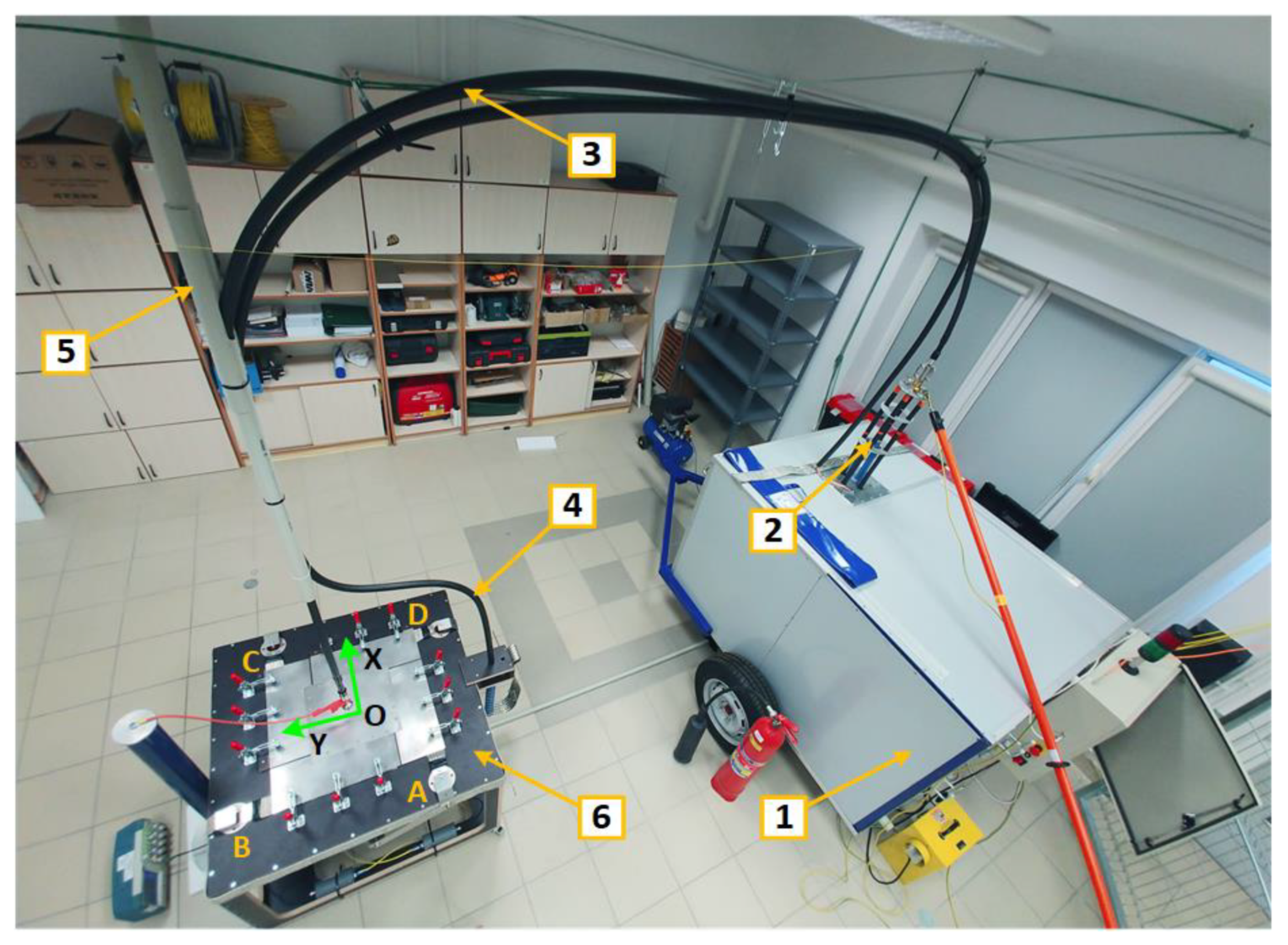
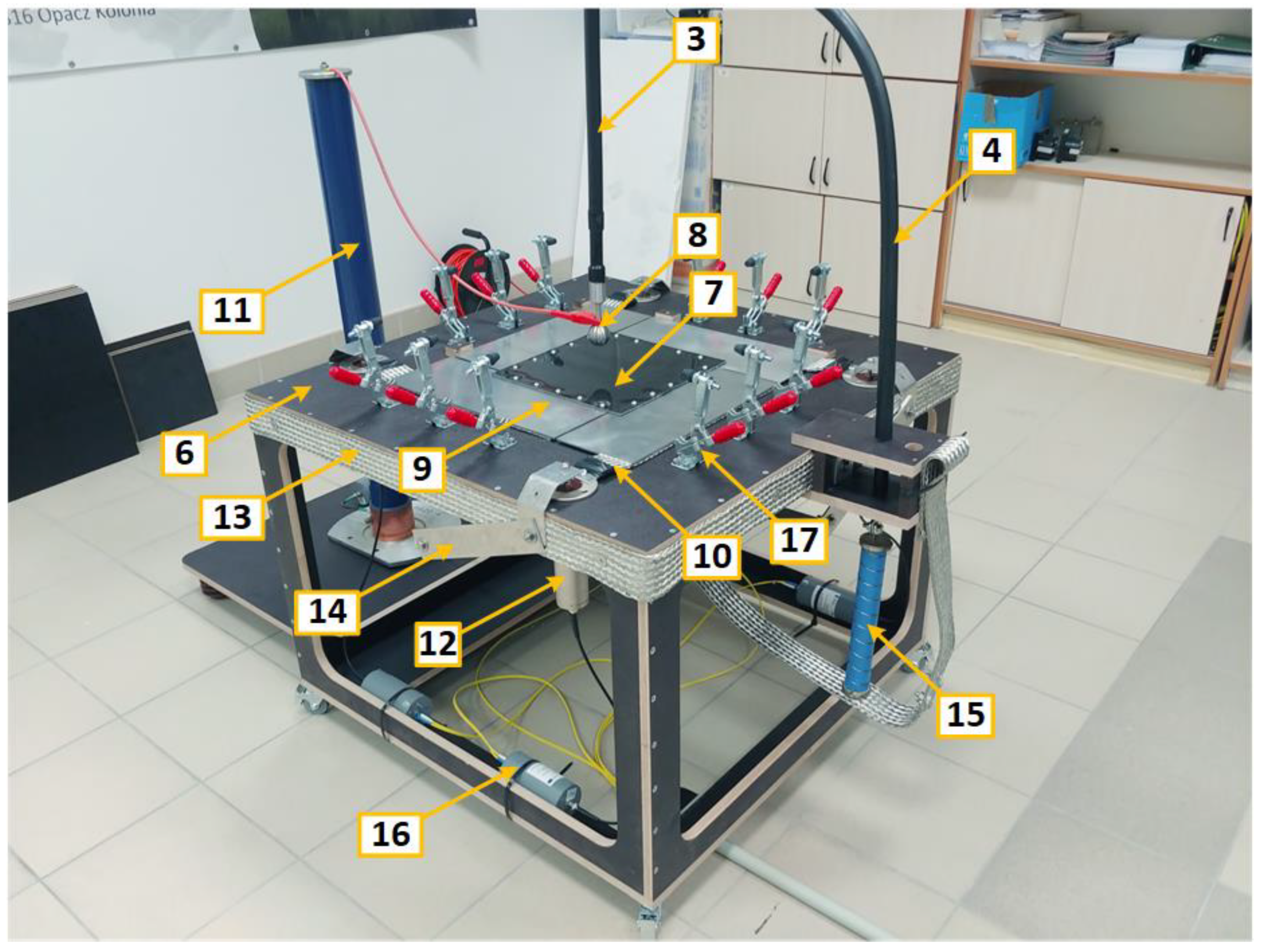
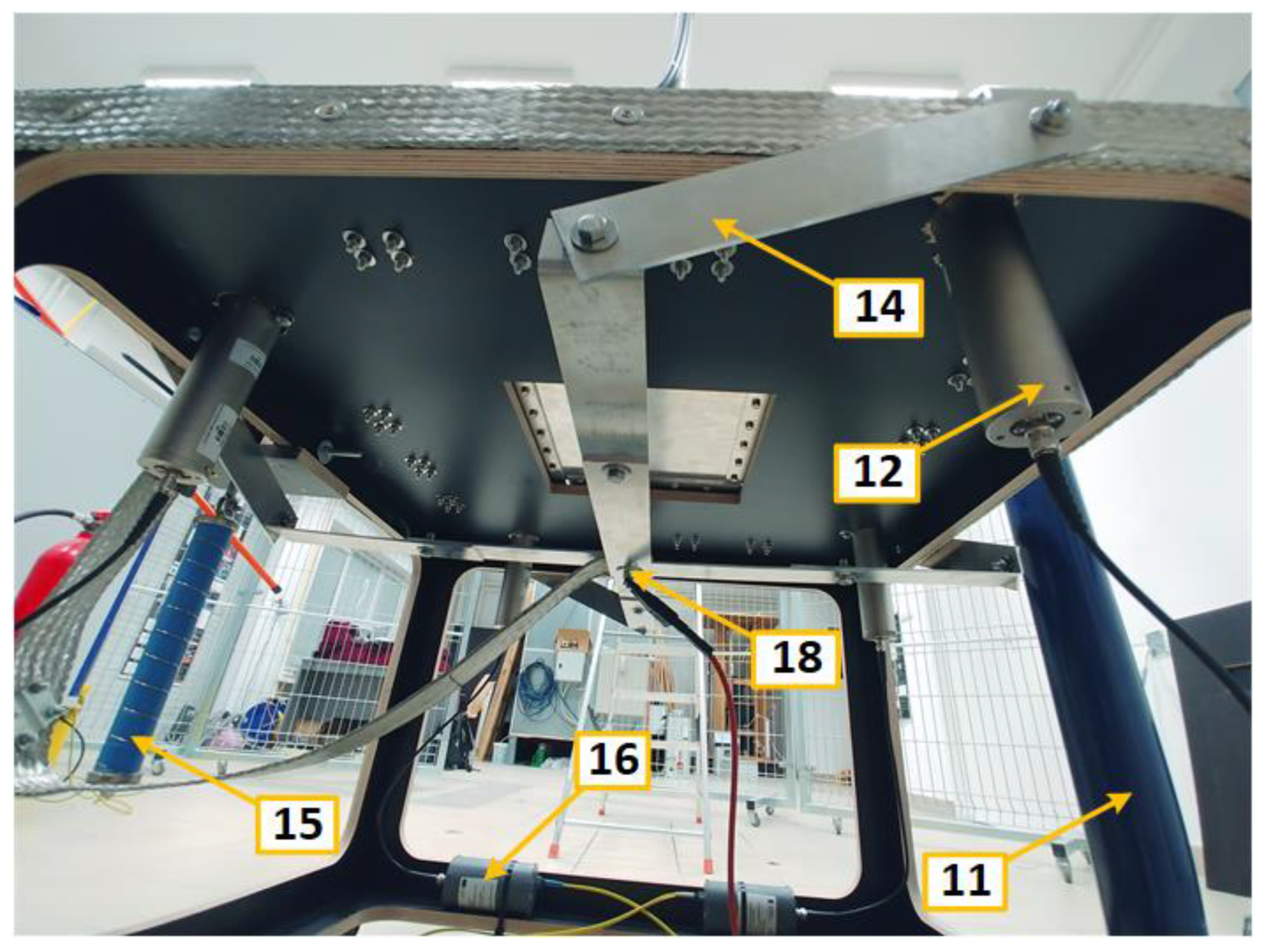
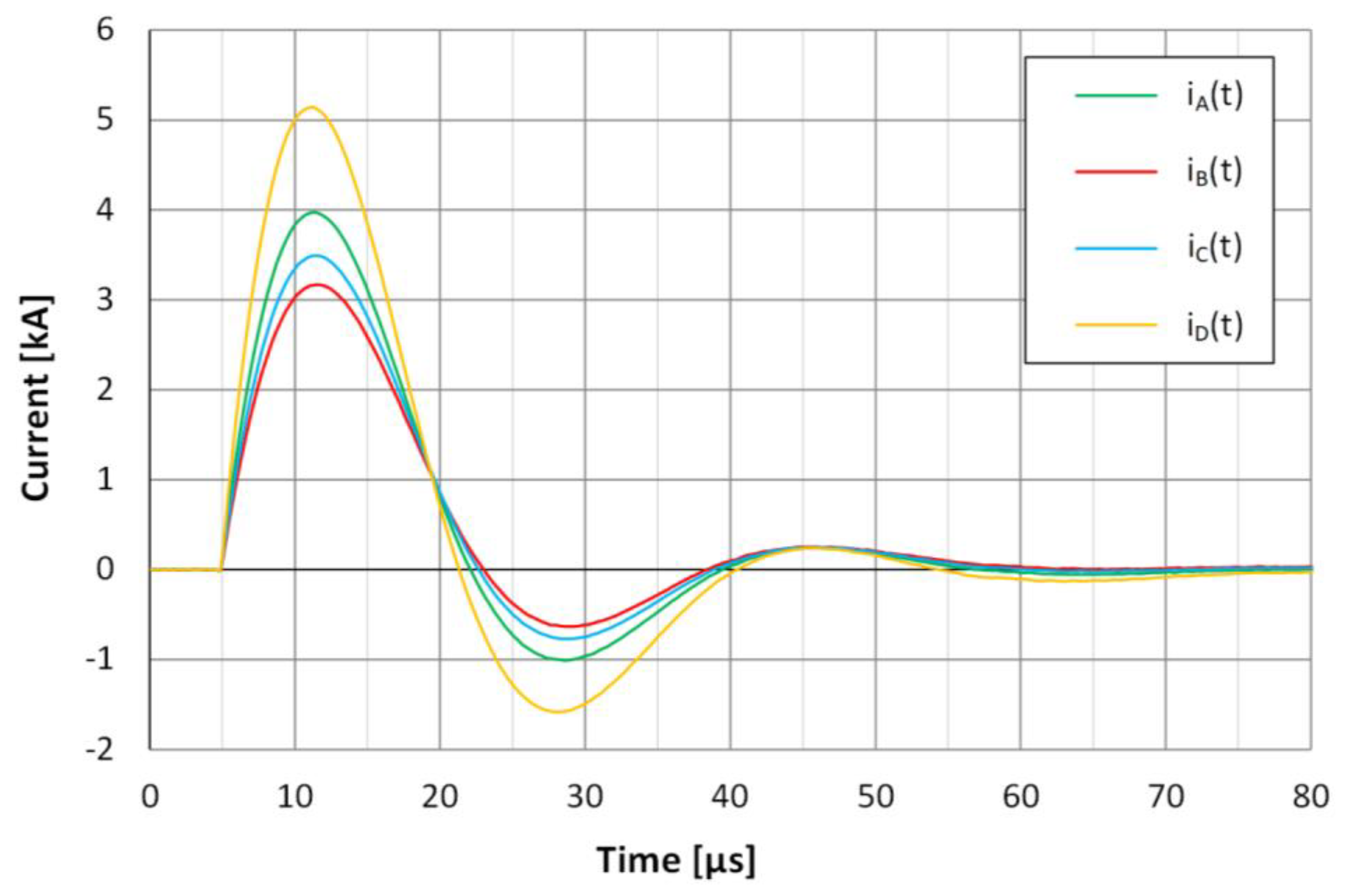



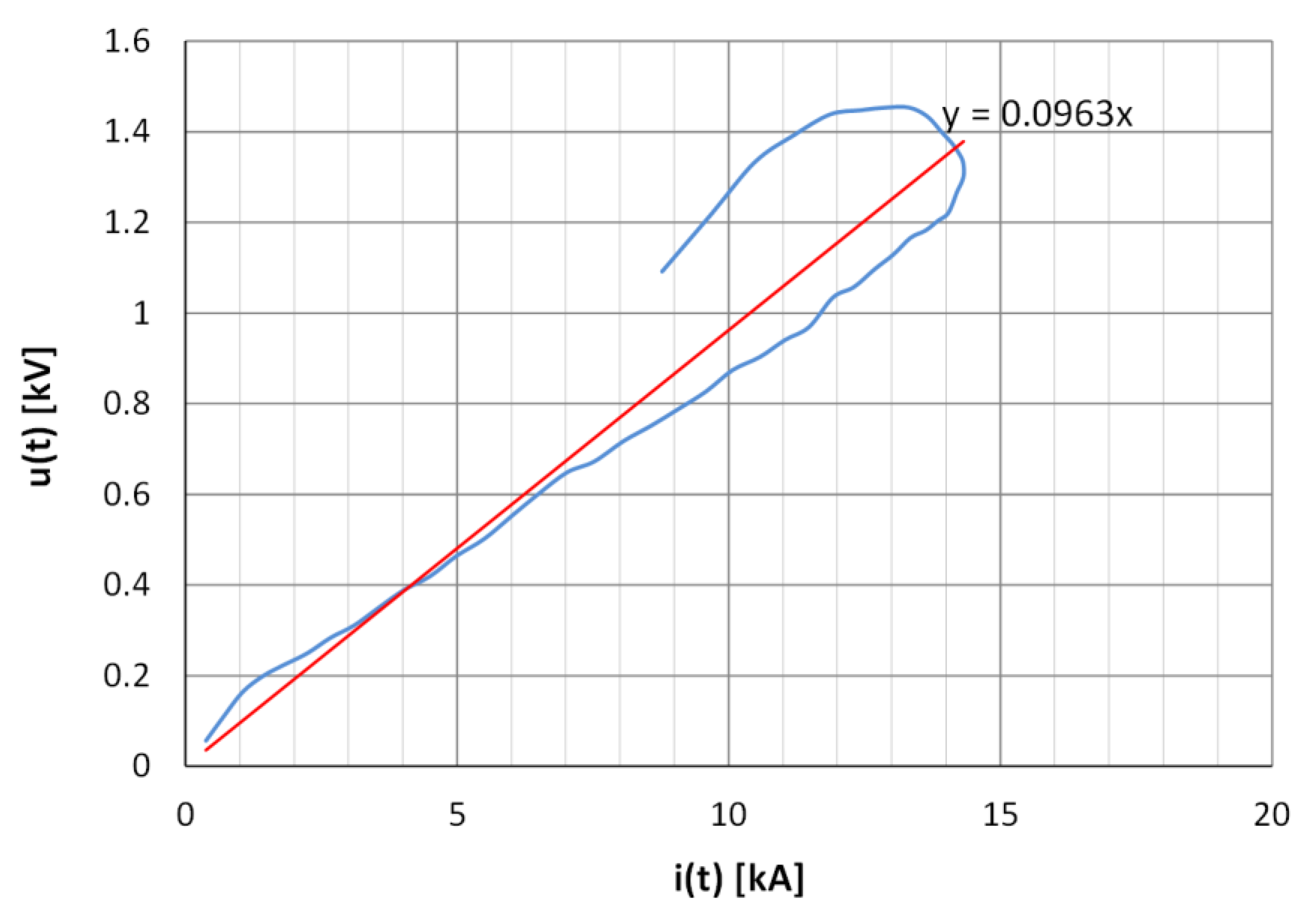
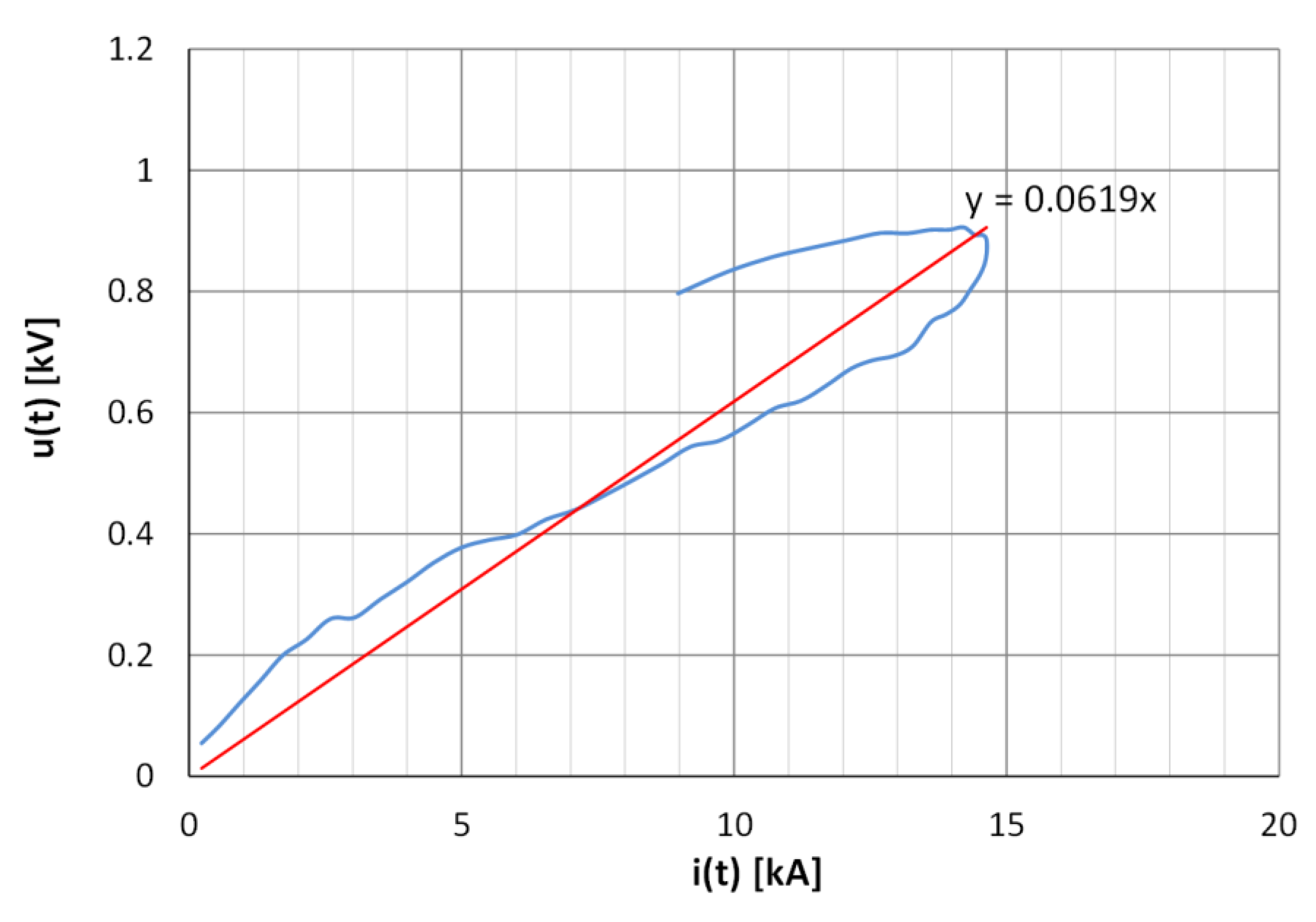

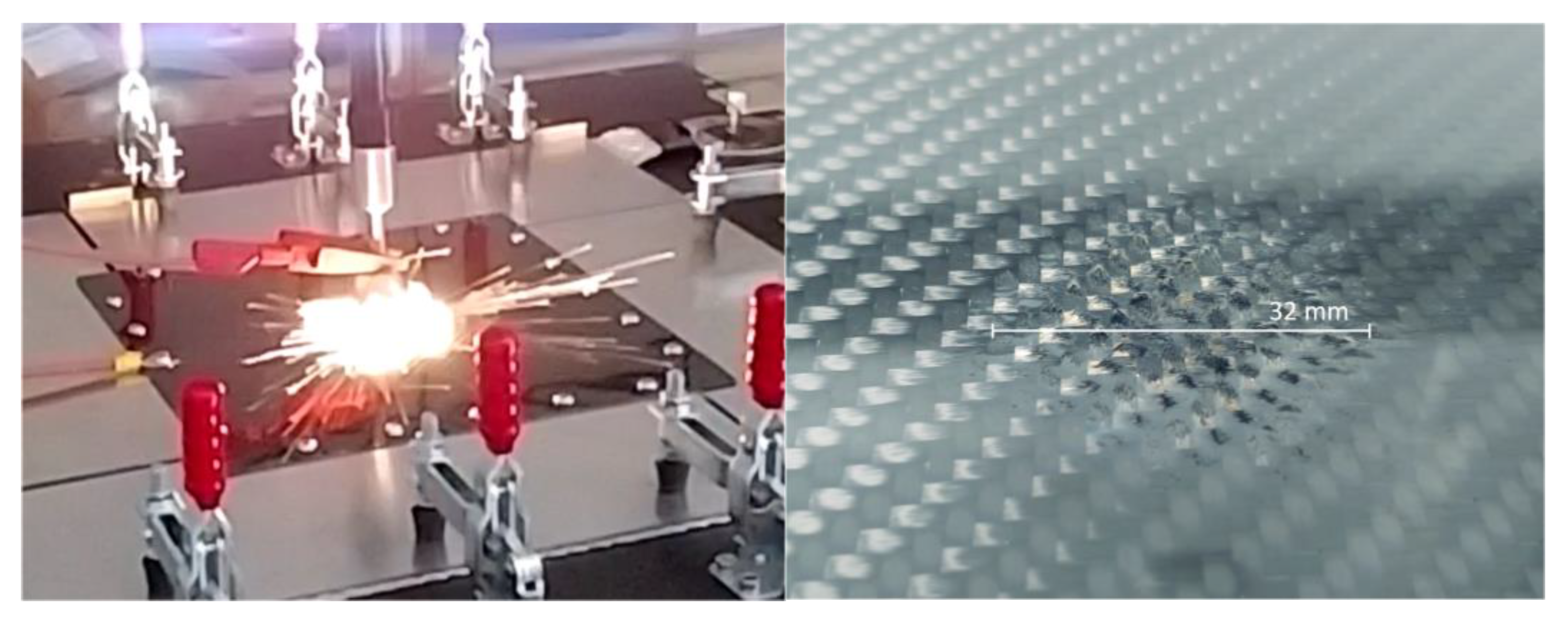
| Specimen | Impulse Number | Peak Values | Z, mΩ | |||||||||
|---|---|---|---|---|---|---|---|---|---|---|---|---|
| IA, kA | IB, kA | IC, kA | ID, kA | I, kA | IA, % | IB, % | IC, % | ID, % | U, kV | |||
| CFRP1 | 1 | 3.46 | 3.37 | 3.07 | 4.47 | 14.32 | 24.2% | 23.5% | 21.4% | 31.2% | 1.57 | 110 |
| 2 | 3.53 | 3.42 | 3.12 | 4.48 | 14.51 | 24.3% | 23.6% | 21.5% | 30.9% | 1.28 | 88 | |
| 3 | 3.55 | 3.46 | 3.15 | 4.48 | 14.6 | 24.3% | 23.7% | 21.6% | 30.7% | 1.36 | 93 | |
| 4 | 3.53 | 3.45 | 3.17 | 4.46 | 14.56 | 24.2% | 23.7% | 21.8% | 30.6% | 1.15 | 79 | |
| 5 | 3.51 | 3.44 | 3.14 | 4.52 | 14.56 | 24.1% | 23.6% | 21.6% | 31.0% | 1.15 | 79 | |
| CFRP2 | 1 | 3.71 | 2.92 | 3.37 | 4.48 | 14.45 | 25.7% | 20.2% | 23.3% | 31.0% | 1.47 | 102 |
| 2 | 3.71 | 2.89 | 3.41 | 4.46 | 14.45 | 25.7% | 20.0% | 23.6% | 30.9% | 1.22 | 84 | |
| 3 | 3.71 | 2.91 | 3.43 | 4.45 | 14.48 | 25.6% | 20.1% | 23.7% | 30.7% | 1.25 | 86 | |
| 4 | 3.71 | 2.91 | 3.43 | 4.46 | 14.48 | 25.6% | 20.1% | 23.7% | 30.8% | 1.18 | 81 | |
| 5 | 3.7 | 2.9 | 3.42 | 4.45 | 14.46 | 25.6% | 20.1% | 23.7% | 30.8% | 1.17 | 81 | |
| CFRP3 | 1 | 3.68 | 3.18 | 3.5 | 4.3 | 14.66 | 25.1% | 21.7% | 23.9% | 29.3% | 1.2 | 82 |
| 2 | 3.65 | 3.2 | 3.48 | 4.32 | 14.63 | 24.9% | 21.9% | 23.8% | 29.5% | 1.13 | 77 | |
| 3 | 3.68 | 3.2 | 3.48 | 4.33 | 14.65 | 25.1% | 21.8% | 23.8% | 29.6% | 1.13 | 77 | |
| 4 | 3.68 | 3.19 | 3.47 | 4.32 | 14.64 | 25.1% | 21.8% | 23.7% | 29.5% | 1.13 | 77 | |
| 5 | 3.68 | 3.18 | 3.48 | 4.34 | 14.63 | 25.2% | 21.7% | 23.8% | 29.7% | 1.12 | 77 | |
Publisher’s Note: MDPI stays neutral with regard to jurisdictional claims in published maps and institutional affiliations. |
© 2021 by the authors. Licensee MDPI, Basel, Switzerland. This article is an open access article distributed under the terms and conditions of the Creative Commons Attribution (CC BY) license (https://creativecommons.org/licenses/by/4.0/).
Share and Cite
Filik, K.; Karnas, G.; Masłowski, G.; Oleksy, M.; Oliwa, R.; Bulanda, K. Testing of Conductive Carbon Fiber Reinforced Polymer Composites Using Current Impulses Simulating Lightning Effects. Energies 2021, 14, 7899. https://doi.org/10.3390/en14237899
Filik K, Karnas G, Masłowski G, Oleksy M, Oliwa R, Bulanda K. Testing of Conductive Carbon Fiber Reinforced Polymer Composites Using Current Impulses Simulating Lightning Effects. Energies. 2021; 14(23):7899. https://doi.org/10.3390/en14237899
Chicago/Turabian StyleFilik, Kamil, Grzegorz Karnas, Grzegorz Masłowski, Mariusz Oleksy, Rafał Oliwa, and Katarzyna Bulanda. 2021. "Testing of Conductive Carbon Fiber Reinforced Polymer Composites Using Current Impulses Simulating Lightning Effects" Energies 14, no. 23: 7899. https://doi.org/10.3390/en14237899






